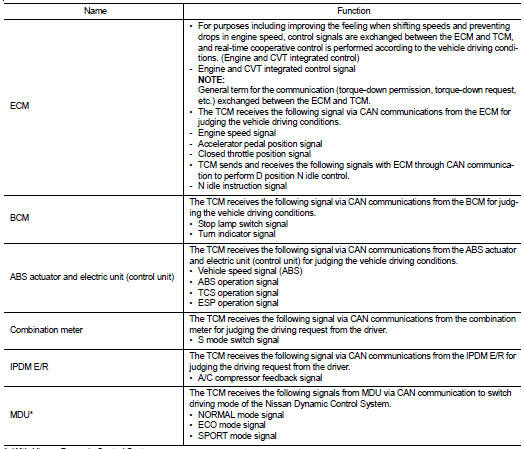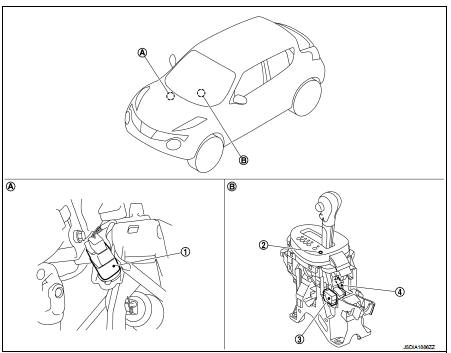Nissan Juke Service and Repair Manual : Component parts
CVT control system : Component Parts Location

1. Multi display unit (MDU)* Refer to DMS-3, "Component Parts Location".
2. Combination meter 3. S mode indicator (On the combination meter) 4. Shift position indicator (On the combination meter) 5. Malfunction indicator lamp (MIL) (On the combination meter) 6. ABS actuator and electric unit (control unit) Refer to BRC-97, "Component Parts Location" (With ESP), BRC-9, "Component Parts Location" (Without ESP).
7. ECM Refer to EC-455, "ENGINE CONTROL SYSTEM : Component Parts Location".
8. IPDM E/R Refer to PCS-5, "Component Parts Location" (With Intelligent Key system), PCS-5, "Component Parts Location" (Without Intelligent Key system).
9. BCM
Refer to BCS-6, "BODY CONTROL
SYSTEM : Component Parts Location"
(With Intelligent Key system), BCS-96,
"BODY CONTROL SYSTEM : Component
Parts Location" (Without Intelligent
Key system)
10. Stop lamp switch
11. Transmission range switch
12. Primary speed sensor
13. CVT unit connector
14. Control valve assembly
15. Output speed sensor
16. Secondary speed sensor
17. TCM
18. S mode switch
19. G sensor
A. Brake pedal, upper
B. Transaxle assembly
C. Engine room
D. CVT shift selector assembly
E. Driver seat (LHD) or passenger seat
(RHD), under
*: With Nissan Dynamic Control System
NOTE
:
The following components are included in control valve assembly (14).
• CVT fluid temperature sensor
• Secondary pressure sensor
• ROM assembly
• Line pressure solenoid valve
• Low brake solenoid valve
• High clutch & reverse brake solenoid valve
• Torque converter clutch solenoid valve
CVT control system : Component Description


*: With Nissan Dynamic Control System
CVT control system : TCM
• The vehicle driving status is judged based on the signals from the sensors, switches, and other control units, and the optimal transaxle control is performed.
• For TCM control items, refer to TM-329, "CVT CONTROL SYSTEM : System Description".
System : System Description".
• The transmission range switch is installed to upper part of transaxle case.
• The transmission range switch detects the selector lever position.
CVT control system : Primary Speed Sensor
• The primary speed sensor is installed to side cover of transaxle.
• The primary speed sensor detects primary pulley speed.
• The primary speed sensor generates the ON-OFF pulse (short waveform) in proportion to the rotating body speed which is “The higher the rotating body speed is, the faster the change cycle is”. The TCM judges the rotating speed from the changing cycle of this pulse signal.

CVT control system : Secondary Speed Sensor
• The secondary speed sensor is installed to side cover of transaxle.
• The secondary speed sensor detects secondary pulley speed.
• The secondary speed sensor generates the ON-OFF pulse (short waveform) in proportion to the rotating body speed which is “The higher the rotating body speed is, the faster the change cycle is”. The TCM judges the rotating speed from the changing cycle of this pulse signal.

CVT control system : Output Speed Sensor
• The output speed sensor is installed to the back side of transaxle case.
• The output speed sensor detects final gear speed. TCM evaluates the vehicle speed from the final gear revolution.
• The output speed sensor generates the ON-OFF pulse (short waveform) in proportion to the rotating body speed which is “The higher the rotating body speed is, the faster the change cycle is”. The TCM judges the rotating speed from the changing cycle of this pulse signal.

CVT control system : CVT Fluid Temperature Sensor
• The CVT fluid temperature sensor is installed to control valve.
• The CVT fluid temperature sensor detects CVT fluid temperature in oil pan.
• The fluid temperature sensor uses a thermistor, and changes the signal voltage by converting changes in the CVT fluid temperature to a resistance value. TCM evaluates the CVT fluid temperature from the signal voltage value.

CVT control system : Secondary Pressure Sensor
• The secondary pressure sensor is installed to control valve.
• The secondary pressure sensor detects the pressure applied to the secondary pulley.
• When pressure is applied to the ceramic device in the secondary pressure sensor, the ceramic device is deformed, resulting in voltage change. TCM evaluates the secondary pressure from its voltage change. Voltage is increased along with pressure increase.

CVT control system : Primary Pressure Solenoid Valve
• The primary pressure solenoid valve is installed to control valve.
• The primary pressure solenoid valve controls the primary pressure control valve. For information about the primary pressure control valve, refer to TM-325, "TRANSAXLE : Component Description".
• The primary pressure solenoid valve uses the linear solenoid valve [N/H (normal high) type].
NOTE
:
• The principle of the linear solenoid valve utilizes the fact that the force
pressing on the valve spool installed
inside the coil increases nearly in proportion to the current. This allows it to
produce a fluid pressure that is
proportional to this pressing force.
• The N/H (normal high) produces hydraulic control when the coil is not energized.
CVT control system : Low Brake Solenoid Valv
• The low brake solenoid valve is installed to control valve.
• The low brake solenoid valve adjusts the tightening pressure of the low brake.
• The low brake solenoid valve uses the linear solenoid valve [N/L (normal low) type].
NOTE
:
• The principle of the linear solenoid valve utilizes the fact that the force
pressing on the valve spool installed
inside the coil increases nearly in proportion to the current. This allows it to
produce a fluid pressure that is
proportional to this pressing force.
• The N/L (normal low) type does not produce hydraulic control when the coil is not energized.
CVT control system : High Clutch & Reverse Brake Solenoid Valve
• The high clutch & reverse brake solenoid valve is installed to control valve.
• The high clutch & reverse brake solenoid valve adjusts the tightening pressure of the high clutch and reverse brake.
• The high clutch & reverse brake solenoid valve uses the linear solenoid valve [N/H (normal high) type].
NOTE
:
• The principle of the linear solenoid valve utilizes the fact that the force
pressing on the valve spool installed
inside the coil increases nearly in proportion to the current. This allows it to
produce a fluid pressure that is
proportional to this pressing force.
• The N/H (normal high) produces hydraulic control when the coil is not energized.
CVT control system : Torque Converter Clutch Solenoid Valve
• The torque converter clutch solenoid valve is installed to control valve.
• The torque converter clutch solenoid valve controls the torque converter clutch control valve. For information about the torque converter clutch control valve, refer to TM-325, "TRANSAXLE : Component Description".
• The torque converter clutch solenoid valve utilizes a linear solenoid valve [N/L (normal low) type].
NOTE
:
• The principle of the linear solenoid valve utilizes the fact that the force
pressing on the valve spool installed
inside the coil increases nearly in proportion to the current. This allows it to
produce a fluid pressure that is
proportional to this pressing force.
• The N/L (normal low) type does not produce hydraulic control when the coil is not energized.
CVT control system : Line Pressure Solenoid Valv
• The line pressure solenoid valve is installed to control valve.
• The line pressure solenoid valve controls the pressure regulator valve. For information about the pressure regulator valve, refer to TM-325, "TRANSAXLE : Component Description".
• The line pressure solenoid valve uses the linear solenoid valve [N/H (normal high) type].
NOTE
:
• The principle of the linear solenoid valve utilizes the fact that the force
pressing on the valve spool installed
inside the coil increases nearly in proportion to the current. This allows it to
produce a fluid pressure that is
proportional to this pressing force.
• The N/H (normal high) produces hydraulic control when the coil is not energized.
CVT control system : G Sensor
• G sensor is installed to floor under instrument lower cover.
• G sensor detects front/rear G and inclination applied to the vehicle.
• G sensor converts front/rear G and inclination applied to the vehicle to voltage signal. TCM evaluates front/ rear G and inclination angle of the vehicle from the voltage signal.
CVT control system : S Mode Switch
• The S mode switch is installed to the selector lever knob.
• When the S mode indicator on the combination meter is OFF and the S mode switch is pressed, the S mode is active and the S mode indicator is ON.
• When the S mode indicator on the combination meter is ON and the S mode switch is pressed, the S mode is cancelled and the S mode indicator is OFF.
CVT control system : S Mode Indicator
• S mode indicator is positioned on the combination meter.
• The S mode indicator is ON when set to the S mode.
• S mode indicator turns on for a certain period of time when the ignition switch turns ON, and then turns off.

CVT control system : Shift Position Indica
TCM transmits shift position signal to combination meter via CAN communication. The actual shift position is displayed on combination meter according to the signal.
A/T shift lock system : Component Parts Location

1. Stop lamp switch
2. Shift lock release button
3. Shift lock solenoid
4. Park position switch
A: Brake pedal, upper B: CVT shift selector assembly
A/T shift lock system : Component Desc

 Structure and operation
Structure and operation
Transaxle : Cross-Sectional View
1. Converter housing
2. Oil pump
3. Counter drive gear
4. Control valve
5. Oil pan
6. Primary pulley
7. Steel belt
8. Secondary pulley
9. Planetary ge ...
Other materials:
Checking bulbs
With all doors closed, apply the parking brake and place the ignition switch
in the ON position without starting the engine. The following lights will come on:
,
or
,
,
,
,
,
The following lights come on briefly and then go off (if so equipped):
,
or
,
,
,
,
,
,
,
,
,
If ...
B210D starter relay
DTC Logic
DTC DETECTION LOGIC
NOTE:
If DTC B210D is displayed with DTC U1000, first perform the trouble diagnosis
for DTC U1000. Refer to PCS-
30, "DTC Logic".
DTC CONFIRMATION PROCEDURE
1.PERFORM DTC CONFIRMATION PROCEDURE 1
1. Press push-button ignition switch under the follow ...
B2627 outside antenna
DTC Logic
DTC DETECTION LOGIC
DTC CONFIRMATION PROCEDURE
1.PERFORM DTC CONFIRMATION PROCEDURE
1. Disconnect outside key antenna (passenger side) connector.
2. Perform “INTELLIGENT KEY” Self Diagnostic Result.
Is outside key antenna DTC detected?
YES >> Refer to DLK-63, "Diagnos ...

